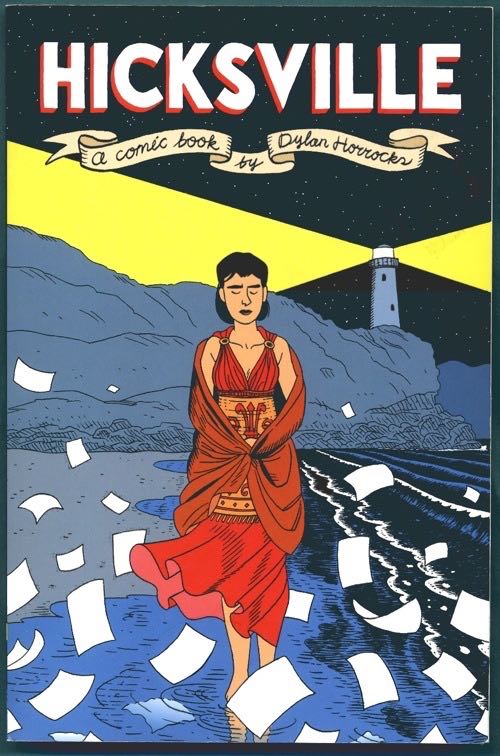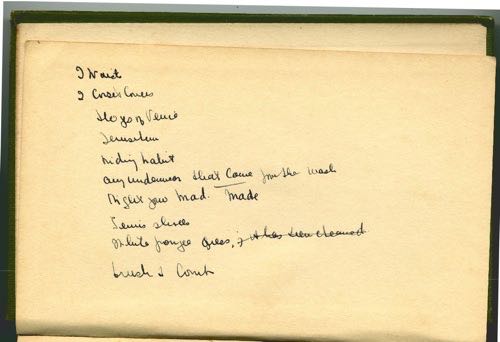
July-August 2010

28 August 10
The Bookshelves of Bolinas
The loft bookshelves of [AL], Bolinas, Marin county, Calif. 26-VIII-10 :


The bookshelves of [JB], Bolinas, Marin county, Calif. 26-VIII-10 :
— Tony Judt. Ill Fares the Land . Penguin Press, 2010. A short and compelling book dealing with “ the urgency of a return to an ethically informed public conversation ” The book examines the failures of the left in presenting a viable alternative to the (failed) model of government enacted by the neo-conservatives. I found his discussion of “ social provision ” particularly interesting, as in, for example, this passage on public transportation (railroads) :
No single person is going to set aside sufficient funds to pay the economic cost of supporting such a service for the rare moments when she uses it. Only the collectivity — the state, the government, the local authorities — can do this. The subsidy required will always appear inefficient in the eyes of a certain sort of economist : would it not be cheaper to rip up the tracks and let everyone use their car ?
Members of a community work together to create resources to be used by all (libraries, public transport, hospitals) precisely because the economic cost is too great for any single individual.
I have already given away the copy I bought at Point Reyes Books ; I shall buy and give a few more copies of Ill Fares the Land , and I want to re-read the book and have it at hand for reference.
— John D. MacDonald. The Lonely Silver Rain (1985 ; Ballantine paperback, 1986). Re-read, the last of the Travis McGee novels.
— Dylan Horrocks. Hicksville. A Comic Book . (1998 ; Drawn and Quarterly Publications, 2010). Wonderful, layered meta-narrative graphic novel history of a history of graphic novels, deft in drawing style and digressive plotting, with a Borgesian library of unpublished works in a remote lighthouse on the coast of the north island of New Zealand.
19 August 10
Living Alone
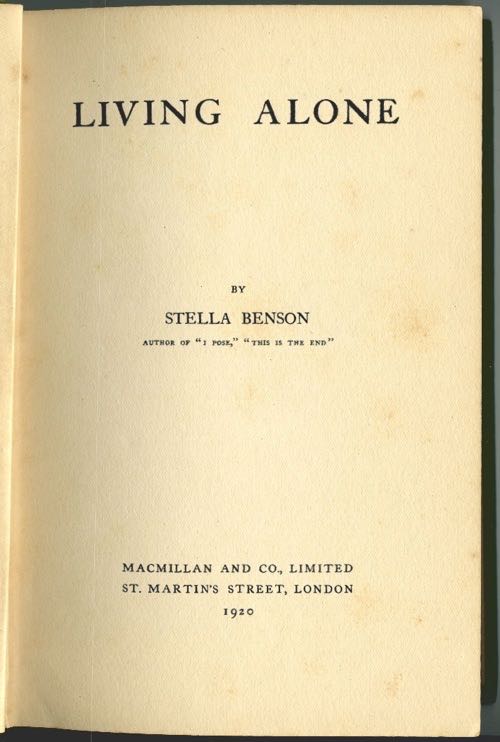
— Stella Benson. Living Alone. Macmillan and Co., [1919 ; second printing,] 1920. An unassuming green book that is an eruption of the magical into the quotidian drudgery of wartime London. A book that soars, and opens the way from Kensington into Faery ; it is also a book that plumbs dark corners of depression. The House of Living Alone is a playful whimsy that reveals it to be a more complex notion than simply a general shop with a boarding house attached.
“ Did you think you had destroyed the House of Living Alone ? Did you think you could escape from it ? ”
There is a brilliant tension between the aloneness of the Witch (most beautifully alone) and the dispirited aloneness of Sarah Brown. It powers the book but is unresolvable, ultimately. Some elements of the story combine neatly — the other lodger at Living Alone is the True Love of the changeling fairy prince, who cares for ordinary rank and class — but the story of Sarah Brown and her dog David underpinning the novel is bleak. One senses the novel deflating, except for the fact that great sentences are everywhere in the book — such as this night time passage :
“ You are smaller than a star, and yet you make more noise than all the stars together. You are not so cold as the moon, and yet your teeth chatter more loudly than hers. The heat of your wrath is less than the heat of the sun, and yet, while he is silent and departed, you fill the air with clamour, [. . .] if there were no London on this side and no War on that, the silence would be deep enough to fill all the seas of all the worlds. . . . ”
And the concluding sentence resonates a very long way indeed. What a time for the literature of the fantastic was that first decade after the war. I suspect Benson’s book was very widely read — by writers at the very least.
Laundry List
Found in the back of Living Alone by Stella Benson, along with the following reading list or log :
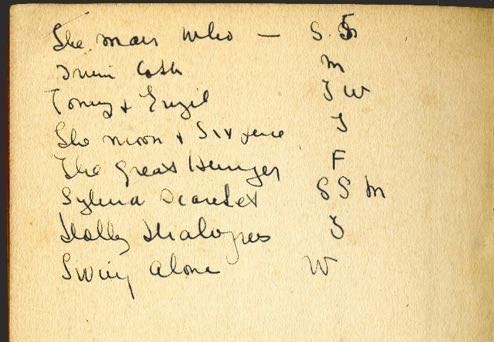
and bearing this interesting ownership signature :
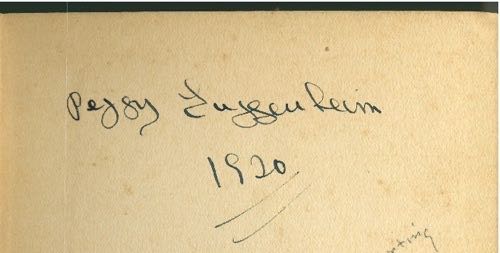
“ In addition to the loneliness imposed by her restrictive home life, her childhood was marked by her father’s death in the 1912 Titanic disaster. After Peggy finished high school, her older sister persuaded her not to attend college; instead, she worked briefly for the Defense Department during the war and then at the Sunwise Turn, a radical bookshop and her first exposure to the cultural avant-garde. In 1919, having come into her $450,000 inheritance, Guggenheim moved to Paris. There she fell in with the bohemian expatriate community. It was during this time that she began her career as an art patron, sending money to writer Djuna Barnes, who received a monthly check from her into the 1970s ” (ANB). It is tempting to conjecture that the shop on Mitten Island, and the benevolent witch who ran it, served as an inspiration and “ business model ” for Guggenheim’s art gallery and benevolent activities.
Books received
Your correspondent has recently received a book with an exotic imprint, beautiful beyond words and a gift of the author. I will read it and comment soon (just not right now).
— The Wesleyan Anthology of Science Fiction , eds. Arthur B. Evans et al. Wesleyan University Press, 2010. Anthology of 52 stories from Hawthorne to Gibson and Gunn and Stross and Chiang.
Recent reading
— Peter Straub. A Dark Matter. A Novel .
Doubleday, [2010]. A knotty, profoundly enjoyable book, serious yet
with hilarious moments ; it seems the product of time lived and
time written. I have heard Straub read from this book on a couple of
occasions.
— Bill Pronzini. Deadfall . St. Martin’s Press,
[1986] [Re-read]. I read another recent novel of his, Fever , and
Pronzini’s Nameless Detective series certainly is one where the author
attempts to escape the box of writing the same book again and again.
— Gene Wolfe. The Sorcerer’s House . Tor, [2010].
A simple midwestern tale of an ex-con with good fortune, anything but simple.
3 August 10
‘ Fleeting Notations ’
No. 43 in Michael Swanwick’s series of 42 short stories for
Clarion West, about Eileen Gunn & HW & an elusive master, here :
http://floggingbabel.blogspot.com/2010/08/yes-in-world.html
And a reminder that Hope-in-the-Mist by Michael Swanwick has been nominated for a Hugo for best related work. The awards are to be announced at Worldcon within a month.
Recent reading :
— Elizabeth Knox. Black Oxen. A Novel (2001 ; Picador USA paperback, 2002). Very complex novel of multiple worlds — “ two worlds with their heads together ” — in a not too distant near future, much of the novel looking back to a fully rendered 1980s populist revolution in a Latin American country, Lequama, with richly evoked indigenous culture. Within the first fifteen pages there are at least four layers of worlds intersecting in the person of Abra, also known as Ido Idea and Walter Risk, whom the reader later learns is the father of Carme Risk, whose “narrative therapy ” in the year 2022 unlocks the stories that are Black Oxen . The first transition is the most astonishing of all, in part because of its deceptive simplicity :
He sat on the hill and listened. He heard the voices of the two men recede — he couldn’t understand what they were saying. He heard a marsh bird boom. Behind that was something he had never heard, and couldn’t hear , that he worked out only a moment later — when he did hear a truck on the bridge — was the sound of many square miles of antique silence, the silence of a place without engines.
The Difficulty — the “ structural obstacles ” of the narrative levels of Black Oxen — is carefully erected and entirely justified by where Knox goes with her anthropological, linguistic, and poetical material.
— Mikhail Bulgakov. The Master and Margarita . Translated from the original Russian by Mirra Ginsburg (Grove Press paperback).
— Dennis Tafoya. The Wolves of Fairmount Park . Minotaur Books, 2010. During a recent visit to the public library, how could I resist this title ? A crime novel with multiple narrative perspectives (cops, criminals, victims, bystanders), set in Philadelphia. Deftly written and well paced, with some grim characters, not unlike the Duke who said he was “ a wolf, only the difference was, a wolf’s skin was hairy on the outside, his on the inside ”. * One memorable passage, pp. 97-8 :
“ I think of them. Moving, slow, down the bottom of the river. Nothing to stop them, nothing to hold on to. Even if they could reach out, what would there be ? Just the silt, that slick black silt ? The smooth stones and cold water and nothing to stop them till they come to the sea. ”
Except that one “ of them ” doesn’t reach the sea.
* The Tragedy of the Duchess of Malfi
22 July 10
« Ausflüge in die Vergangenheit » : Mit der Geschwindigkeit des Sommers

— Julia Schoch. Mit der Geschwindigkeit des Sommers. Roman . Piper, [2009]. 149 pp.
Und heute ein Rezensionsbrief, das Geschenk von [IRR] zu bedanken.
Mit der Geschwindigkeit des Sommers is a spare, sophisticated novel, recalling events of thirty years ago in a remote military post at the eastern edge of the DDR, interwoven with the further story of the narrator’s older sister, who married, had children, and remained in the isolated place after the 1989 Revolution (known to non-Germans as the fall of the Berlin Wall). Unlike the narrator, she never travelled: she went only once to Berlin; and became preoccupied with the visible traces of the former DDR. She resumed, very discreetly, a liaison with a lover from her wild teenage years; when her husband left her, she travelled to New York where she died by suicide or accidental overdose (she is dead from the first page of the novel).
I read Mit der Geschwindigkeit des Sommers with keen interest, first as a glimpse of a vanished land*, and then with increasing appreciation as a highly developed and almost distilled consideration of memory and invention, past and present, presence and absence, all expressed in arrows of carefully chosen words and elegant imagery. As an example, « Das Haff, das falsche Meer. . . . Als ich letzte Mal dort war, fiel ein gleichmäßiger Nieselregen. Feine Nadeln, die senkrecht in den Spiegel aus Quecksilber drangen » (78). The military base near Stettin was remote and an artificial construct, but in the narrator’s recollections, Schoch makes it pulse with human life.
The heart of the novel is found on pages 61-2, as a philosophical observation, « Ausflüge in die Vergangenheit » [Excursions into the past], and as a poetical image, « . . . und liefen über das verlassene Gelände der ehemaligen Genossenschaft » [and they ran through the abandoned terrain of the former collective**]. How beautiful and tragic is the portrait of the wild sister who remained behind, as she is remembered by her world travelling little sister. The final passage, especially the concluding sentence, is icy and beautiful and philosophical.
I read Mit der Geschwindigkeit des Sommers with pleasure but I have rarely encountered a first-person narrator who is so reluctant to give details of her own life. There are no names, barely a couple of memories of specific incidents of childhood with the sister (hanging on the back of the bicycle) and adolescence (a visit to the cinema); and still less of their existence as adults (telephone calls, and one telling, unannounced visit to the older sister). From the very first page, the author’s diction gives clues to the formal distance between narrator and incident, « Bis ich von ihrem Selbstmord erfuhr . . . » [Until I came to learn of her suicide . . . ]. Erfahren is to experience or to come to know of something; we are never told anything of how or when or from whom she learned this, much less what she thought or felt at the time. A similar poetic but impersonal, almost emotionless diction occurs during a beautiful passage about childhood :
In der Errinerung leben die Kinder wie elternlos in der Siedlung. Ihre Verbindung hinauf in die Wohnungen ist das Schreien, das zurückhallt von den Wänden der Wohnblocks. Die Kinder schreien, anstatt die Treppen zu benutzen. Sie rufen nach den Müttern, manchmal wie in Trance stehen sie, den Kopf iim Nacken, die Augen geschlossen, und hören nicht auf zu rufen. Nach Schlüsseln, belegten Broten, irgendeinem Spielzeug, bis in den Fenstern Arme erscheinen und das gewünschte Ding vor die Füße der schreienden Kinden werfen (45).
A central ambiguity of Mit der Geschwindigkeit des Sommers is whether the sister’s lover from her wild teenage years returned to look her up, or whether this was a fantasy which she embellished during her telephone calls with the narrator. A complex and deeply satisfying book, one that compelled my attention in ways that Der Turm by Uwe Tellkamp, a recent encyclopaedia novel of life in Dresden under the DDR, ultimately did not.
* (the DDR is the one country I regret not having
visited during my time in Bavaria ; I did get to another vanished
land a few times, the Illyrian beaches in Tito’s Yugoslavia)
** (but collective or cooperative society in
English does not evoke the long history of socialist enterprise, nor the
echoes of Marx and Lenin)
Current reading :
— Hannah Green. The Dead of the House [1972]. Books & Co. paperback, [n.d., after 1996] [Gift of EK]. Novel of the many generations of the DeGolyer/Nye families and the love of the narrator Vanessa for her Grandpa. “ I have tried to write, seemingly, a real book, which is, in fact, a dream. ” If Truman Capote applied techniques of the novel to non-fiction to create In Cold Blood (1965), at just about the same time (mid-1960s), Hannah Green was drawing upon the techniques and texts of non-fiction and American belles lettres to create a superb fiction ; the sources of The Dead of the House seem to be the privately printed volumes of poems and family history that line a shelf somewhere in every old house, spiced with explicit references to Longfellow and presidents and wars, and echoes of Whitman and connections to “ real ” life. While reading, I did not know which books Green cites might be actual and which fictive : a joy. And then there is this passage :
“ And I imagined your woods were like that. I thought they existed only there beyond your stone wall and that the only way to go into them was to go through your library and the dining room and the kitchen and out the back door and down by the woodpile and over the stile. I thought that if I did go into your wooods, I would go back into the past and I’d never be able to come out again. ”
— Elizabeth Knox. Black Oxen. A Novel . [2001 ; Picador paperback, 2002] Have just started this, and within the first 15 pages there are at least three very complicated threads to be discerned, great transformations enacted in the simplest of language. [Suggested by another EK].
Your correspondent’s review of Robert A. Heinlein. Volume 1. Learning Curve (1907-1948) by William H. Patterson, Jr., is published in The New York Review of Science Fiction for July 2010.
The issue also includes a great memoir in miniature by Gregory Benford, “ PKD in OC ”, discussing the paranoia and generosity of Philip K. Dick, with this indisputable statement, “ The one person who would not have believed the prominence of Philip Dick in our culture now was Philip Dick himself. ”
Subscription details at : http://www.nyrsf.com.
‘ I love hearing you and Rex tell your stories. . . . You’re such great liars ’

— Stories. All-New Tales. Edited by Neil Gaiman and Al Sarrantonio. William Morrow, 2010. [Dust jacket illustration by Tom Gauld].
A rich but uneven anthology, with some brilliant and ambitious material and some stories that seem meager and perfunctory. “ Let the Past Begin ” by Jonathan Carroll has deft, funny meander of exotic lives in a stressful situation, a love polyhedron, and that playful zig-zagging of overturned expectations that is one of his charms ; but the conclusion is at once deeply ambiguous and very moving. Several of the best I have heard the authors read in the recent past, such as “ The Maiden Flight of McCauley’s Bellerephon ” by Liz Hand ; while Peter Straub has been reading portions of the Mallon tale at dark intervals. And “ Goblin Lake ” by Michael Swanwick has a passage worth noting :
This is the infallible method of discovering on which side of the page you lie Ñ have you read a book this year ?
Neil Gaiman’s “ The Truth Is a Cave in the Black Mountains ” is a spare and relentless tale of vengeance in a Scotland that is a bleak and haunted as any in Buchan’s Witch Wood : “ the curse of age, that all things are reflections of other things ”. “ Polka Dots and Moonbeams ” by Jeffrey Ford has some of the cadences of a Raymond Chandler opening and then the hit of speed kicks in full force and it goes places that did not exist in 1939. “ The Knife ” by Richard Adams, with deft concision, tells an appalling, echoing story in three pages, a tale of boarding school violence with grim twist in the fabric of the narrative. The first portion of “ The Therapist ” by Jeffrey Deaver has a narrative voice so earnest that the reader walks along comfortably and by degrees right across the boundaries of the social contract. Stewart O’Nan’s “ Land of the Lost ” is a tale of how an inward loss translates into expression (and obsession) in the outer world.
The most astonishing of all the stories in Stories is easily “ Stories ” by Michael Moorcock, a maelstrom of a tale, devastating, full of complexities, sorrow, parallels, and ambiguities. It is the story of author Rex Fisch and his long, uneasy friendship with the narrator “ Mike ”. It is a rich tale of London in the 1960s and 1970s, of the ups and downs of a friendship. The narrator is an influential editor and writer who runs through a string of wives, one of whom came to a slow, very sad end. “ Jenny ” is the only character in the story who speaks directly, “ I love hearing you and Rex tell your stories. . . . You’re such great liars ” ; she is also the only character who is never given a surname (before or after her marriage to “ Mike ” This has the feel of a novella à clef, a tale written as fiction because, one senses, writing the truth does not offer the narrator such sufficient opportunities to excuplate himself and shape the way the story is read (and alter mere facts). Moorcock does articulate one compelling point, that sometimes the one story a writer is unable to write is the story of his own life : “ only one story he really had to tell and from deep habit he had repressed it, choosing suicide rather than write it ”.
15 July 10
Recent reading :
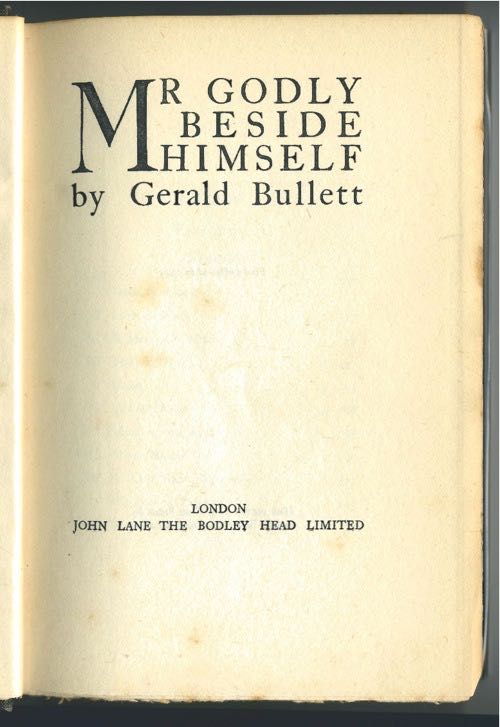
— Gerald Bullett. Mr Godly beside Himself .
John Lane and the Bodley Head Limited, [1924]. A brisk and playful
account of a trip to Fairyland and back, with some interesting elements :
a definite First Contact interaction, however briefly it is developed,
recounting the experiences and perceptions of the fairies upon sighting
a human, and of the changeling double while he was in the human realm
(the insurance office scenes are hilarious) ; the novel records
the wife’s experience with the changeling in parallel to the
husband’s eternal, fleeting kiss from the fairy queen. The novel
starts out with strong echoes of John Buchan’s Huntingtower (1920)
but where Dixon McCunn takes a walk into adventures in Scotland, John
Godly pursues Maia the fairy “ over the hills and far away ” ;
there is a narrative arc somewhat like that of Jurgen (1919) ;
it is a book with quiet echoes throughout the field. A comic treatment,
but not to be dismissed on that ground, for Bullett explicitly addresses “the
touch of eternity ”, the pursuit of the unattainable, loss,
and other issues that figure in the landmark book of 1924 : The
King of Elfland’s Daughter by Dunsany. The 1920s were
some decade for the literature of the fantastic (. . . and
other things literary, too).
Nice title page. [Gift from a friend at Readercon. Thank you, EK]
— Elizabeth Hand. Saffron and Brimstone. Strange Stories. A Collection .
M Press, [2006]. Missed this when it appeared as Bibliomancy .
Especially liked “ The Least Trumps ” with its hommage
to the writings of John Crowley ; and the four stories of “ The
Lost Domain ”.
— Emma Frances Dawson. An Itinterant House and Other Ghost Stories .
Edited by John Pinkney and Robert Eldridge. Portland, Maine : Thomas Loring & Co.,
2007. New edition of a classic 1897 collection of ghost stories, with a biographical
and critical introduction by Robert Eldridge.
— Jeff VanderMeer. The Third Bear (Tachyon, 2010). Collection
of dark fantasy stories, often formally inventive, very dark.
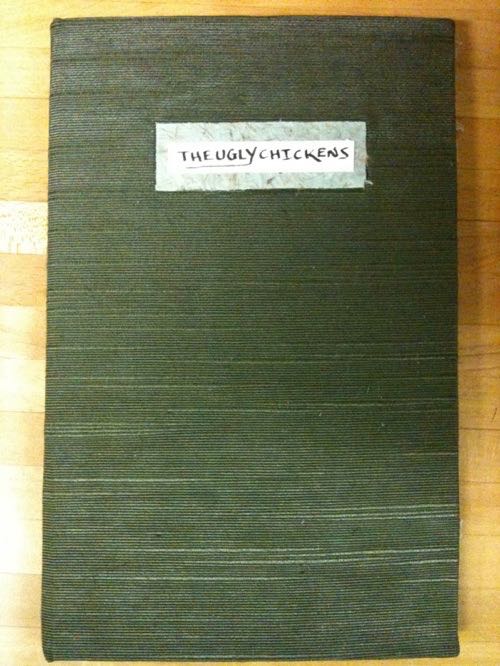
— Howard Waldrop. The Ugly Chickens . Old Earth Books, 2009. Hand bound, edition of 3 copies, for presentation, at Readercon 2010.
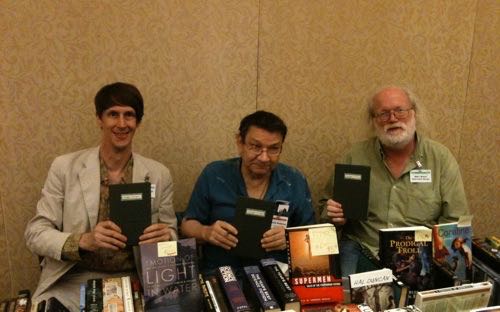
WWW: Henry Wessells (binder), Howard Waldrop (author), Michael Walsh (publisher), 11 July 2010, photo by Chris Edwards.
Readercon 2010
Your correspondent returned to Readercon 21 in Burlington, Mass., last weekend and saw many friends with interests in the literature of the fantastic. Talked about books, bears, and authors (the living and the dead). Remembered to bind the presentation copies of The Ugly Chickens in time to bring them and find author, publisher, and binder together (see above) ; Howard Waldrop read a section of The Moone World , his forthcoming book that gives further account of the life and times of Chas. Dickens of Gads Hill, author of The Mystery of Edwin Drood. In Twelve Parts and subsequent works.
Attended a panel discussion on fan fiction as critical and anthropological phenomena, which offered many interesting notions ; but I remain uncertain as to the degree to which any hermetic (“ closed ”) literature — which term describes some portion of the spectrum of fan fiction — actually participates in an ongoing critical dialogue.
The panel in memoriam elicited many interesting recollections of Phil Klass, Knox Burger, Chas. N. Brown, George Scithers, E.F. Bleiler, and others ; during which John Clute articulated an interesting question, how is one to approach the literary legacy of authors whose personal lives were evil ? Look first at the books is my own response, for which I take my cue from Nabokov, who famously refused to answer questions about his own life. “ There are no novels, no writers, only individual books. ”
The conversation continues.
Wander in the Archives
The Archives of the Endless Bookshelf have been swept and tidied and a guide has been prepared to assist wanderers. Index would be too strong a term : the headwords tend to be suggestive rather than directive. Start here. Have fun.
This creaking and constantly evolving website of the endless bookshelf : I expect that some entries will be brief, others will take the form of more elaborate essays, and eventually I will become adept at incorporating comments or interactivity. Right now you’ll have to send links to me, dear readers. [HWW]
electronym : wessells
at aol dot com
Copyright © 2007-2010
Henry
Wessells and individual contributors.
Produced by Temporary
Culture, P.O.B. 43072, Upper Montclair, NJ 07043 USA.


